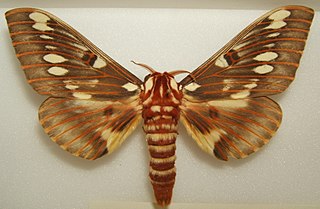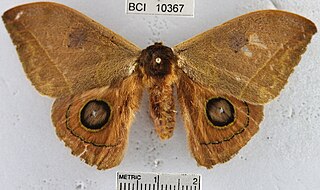
Citheronia splendens, the splendid royal moth, is a moth of the family Saturniidae. It is found from southern Arizona south into central and south-eastern Mexico. The species was first described by Herbert Druce in 1886.

Xylophanes is a genus of moths in the family Sphingidae. As of 2000, there are about 96 species and subspecies included in the genus.

Automeris larra is a moth of the family Saturniidae. It is found in South America, including Brazil, French Guiana, Venezuela, Colombia, Peru, Bolivia and Ecuador.

Automeris metzli is a moth of the family Saturniidae. It is found from Mexico to Venezuela, Colombia and Ecuador and can also be found in Trinidad

Automeris is a genus of moths in the family Saturniidae and the subfamily Hemileucinae. As of 1996 there were 124 species, and more have since been described. These moths are generally characterized by the eyelike patches on the hindwings and the leaflike pattern on the forewings, an example of crypsis. The genus was first described by Jacob Hübner in 1819 and it is distributed in the Neotropic ecozone.

Syssphinx is a genus of moths of the family Saturniidae. The genus was erected by Jacob Hübner in 1819.

Citheronia is a genus of moths in the family Saturniidae. The genus was erected by Jacob Hübner in 1819.

Rhescyntis hippodamia is a species of moth in the family Saturniidae first described by Pieter Cramer in 1777. It is found from Mexico to Brazil.

Automeris duchartrei is a moth of the family Saturniidae first described by Eugène Louis Bouvier in 1936. It is found in Ecuador, Bolivia and Peru.

Automeris zugana is a moth of the family Saturniidae first described by Herbert Druce in 1886. It is found from Panama to western Ecuador. The habitat consists of hyperhumid tropical rain forests at altitudes between 60 and 1,400 meters.

Automeris postalbida is a moth of the family Saturniidae first described by William Schaus in 1900. It is found from Costa Rica to Ecuador.
Conchylodes salamisalis, the blush conchylodes moth, is a moth in the family Crambidae. It was described by Herbert Druce in 1895. It is found in Ecuador, Costa Rica, Panama, Guatemala, Mexico and the southern United States, where it has been recorded from Texas.

Caio championi is a large moth of the family Saturniidae first described by Druce in 1886. It is found from Mexico to Guatemala, south to western Ecuador and northern Venezuela.
Automeris randa, or Rand's eyed silk moth, is a species of buck and io moths in the family Saturniidae. It was described by Herbert Druce in 1894 and is found in Central and North America.
Automeris louisiana, the Louisiana eyed silkmoth, is a species of moth in the family Saturniidae. It is found in North America.
Automeris zephyria, the zephyr eyed silkmoth, is a species of insect in the family Saturniidae. It is found in North America.
Automeris cecrops, the cecrops eyed silkmoth, is a species of insect in the family Saturniidae. It is found in Central America and North America.
Automeris patagoniensis, the Patagonia eyed silkmoth, is a species of insect in the family Saturniidae. It is found in North America.
Automeris iris, the iris eyed silkmoth, is a species of insect in the family Saturniidae. It is found in Central America and North America.














